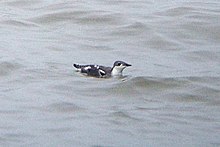Brachyramphus
| Brachyramphus | |
|---|---|

| |
| Long-billed murrelet Brachyramphus perdix | |
| Scientific classification | |
| Domain: | Eukaryota |
| Kingdom: | Animalia |
| Phylum: | Chordata |
| Class: | Aves |
| Order: | Charadriiformes |
| Family: | Alcidae |
| Genus: | Brachyramphus Brandt, JF, 1837 |
| Type species | |
| Colymbus marmoratus Gmelin, JF, 1789
| |
| Species | |
|
B. marmoratus | |
Brachyramphus is a small genus of
Taxonomy
The genus Brachyramphus was introduced in 1837 by the German born naturalist Johann Friedrich von Brandt.[3] The type genus was subsequently designated by George Robert Gray as the marbled murrelet.[4][5] The genus name combines Ancient Greek brakhus meaning "short" with rhamphos meaning "bill".[6]
The genus contains three species:[7]
| Image | Scientific name | Common Name | Distribution |
|---|---|---|---|
 |
Brachyramphus marmoratus | Marbled murrelet | Kenai Peninsula, Barren islands, and Aleutian Islands |
 |
Brachyramphus perdix | Long-billed murrelet | Kamchatka to the Sea of Okhotsk |
 |
Brachyramphus brevirostris | Kittlitz's murrelet | Prince William Sound, the Kenai Peninsula, sparsely up the west coast and along the Aleutian Islands |
These are unusual members of the
These species breed in the subarctic North Pacific. They tend to remain coastal in winter, either staying near the breeding grounds, or, in the case of long-billed, migrating to the coast of Japan.
Two prehistoric species have been described from
Description
These are small chunky auks, no more than 25 cm long. Like other auks, they have plumage that varies by season. The non-breeding appearance is typically white underneath with mainly black upperparts. The breeding plumage is distinctive in this group; most auks are strongly contrasted with black and white when breeding, but Brachyramphus species are mainly brown, with pale feather edges giving a scaly appearance; the central underparts, normally below the surface on a swimming bird, are white.
Behaviour and breeding
Murrelets feed at sea on small fish, larval fish, krill and other small zooplankton. Chicks are fed with larger fish carried in the bill.
The breeding behaviour of this genus is very unusual. Unlike most other seabirds, they do not breed in colonies or even necessarily close to the sea, instead nesting, depending on species, on branches of old-growth
Threats
All three Brachyramphus murrelets are globally threatened and declining in numbers. The biggest threat are the loss of nesting
.References
- ^ "Murrelet". Oxford English Dictionary (Online ed.). Oxford University Press. (Subscription or participating institution membership required.)
- ^ "Murre". Oxford English Dictionary (Online ed.). Oxford University Press. (Subscription or participating institution membership required.)
- ^ von Brandt (1837). "Rapport sur une monographie de la famille des Alcadées". Bulletin Scientifique publié par l'Académie Impériale des Sciences de Saint Pétersbourg (in French). 2 (22). cols. 344-349 [346].
- ^ Gray, George Robert (1840). A List of the Genera of Birds : with an Indication of the Typical Species of Each Genus. London: R. and J.E. Taylor. p. 77.
- ^ Peters, James Lee, ed. (1934). Check-List of Birds of the World. Vol. 2. Cambridge, Massachusetts: Harvard University Press. p. 355.
- ISBN 978-1-4081-2501-4.
- Rasmussen, Pamela, eds. (August 2022). "Noddies, gulls, terns, skimmers, skuas, auks". IOC World Bird List Version 12.2. International Ornithologists' Union. Retrieved 9 November 2022.
- JSTOR 1369851.
Further reading
- Maumary, Lionel and Peter Knaus (2000) Marbled Murrelet in Switzerland: a Pacific Ocean auk new to the Western Palearctic Archived 2016-07-01 at the conspecificwith Marbled Murrelet; the latter species has not occurred in Europe)
